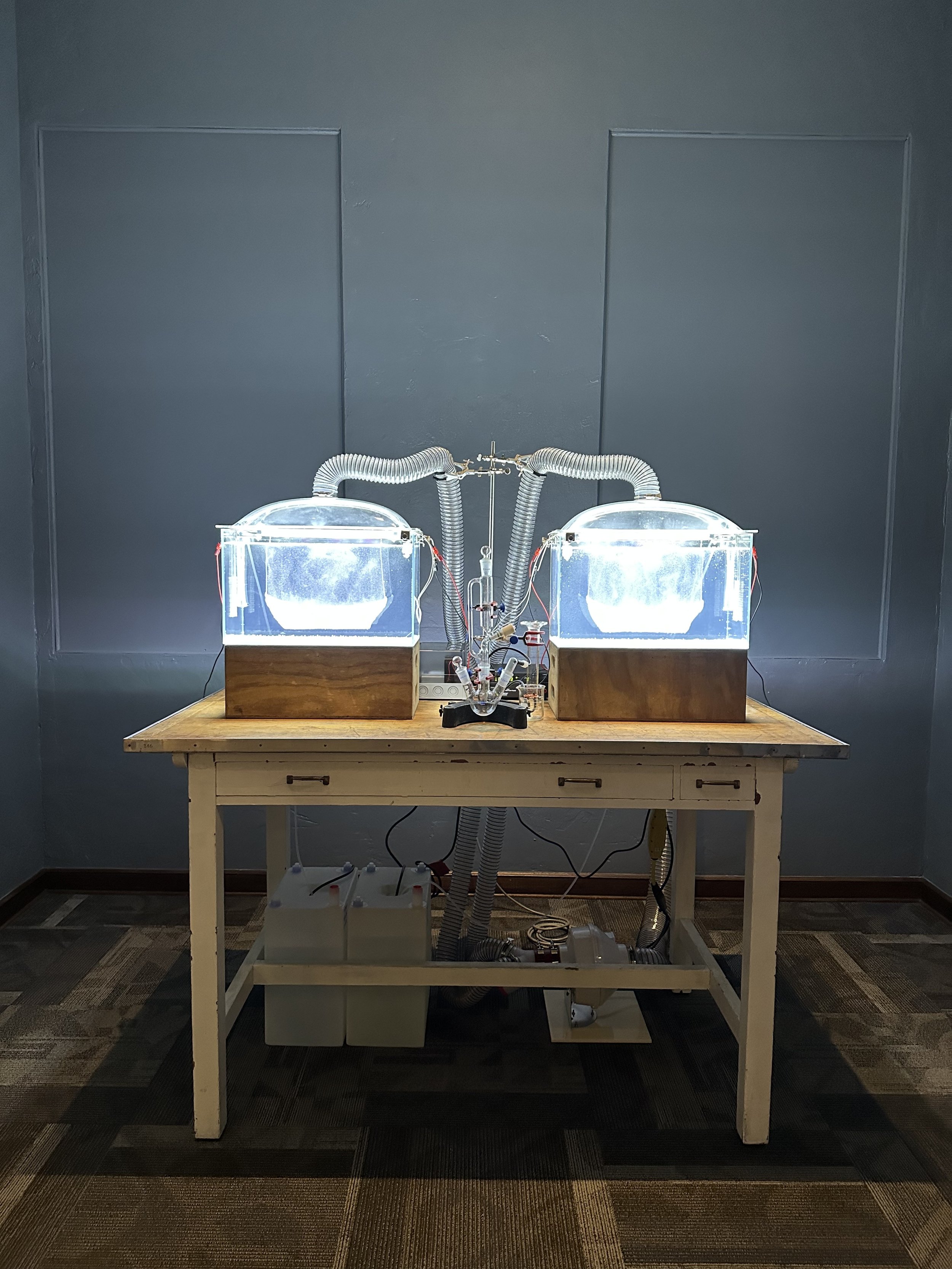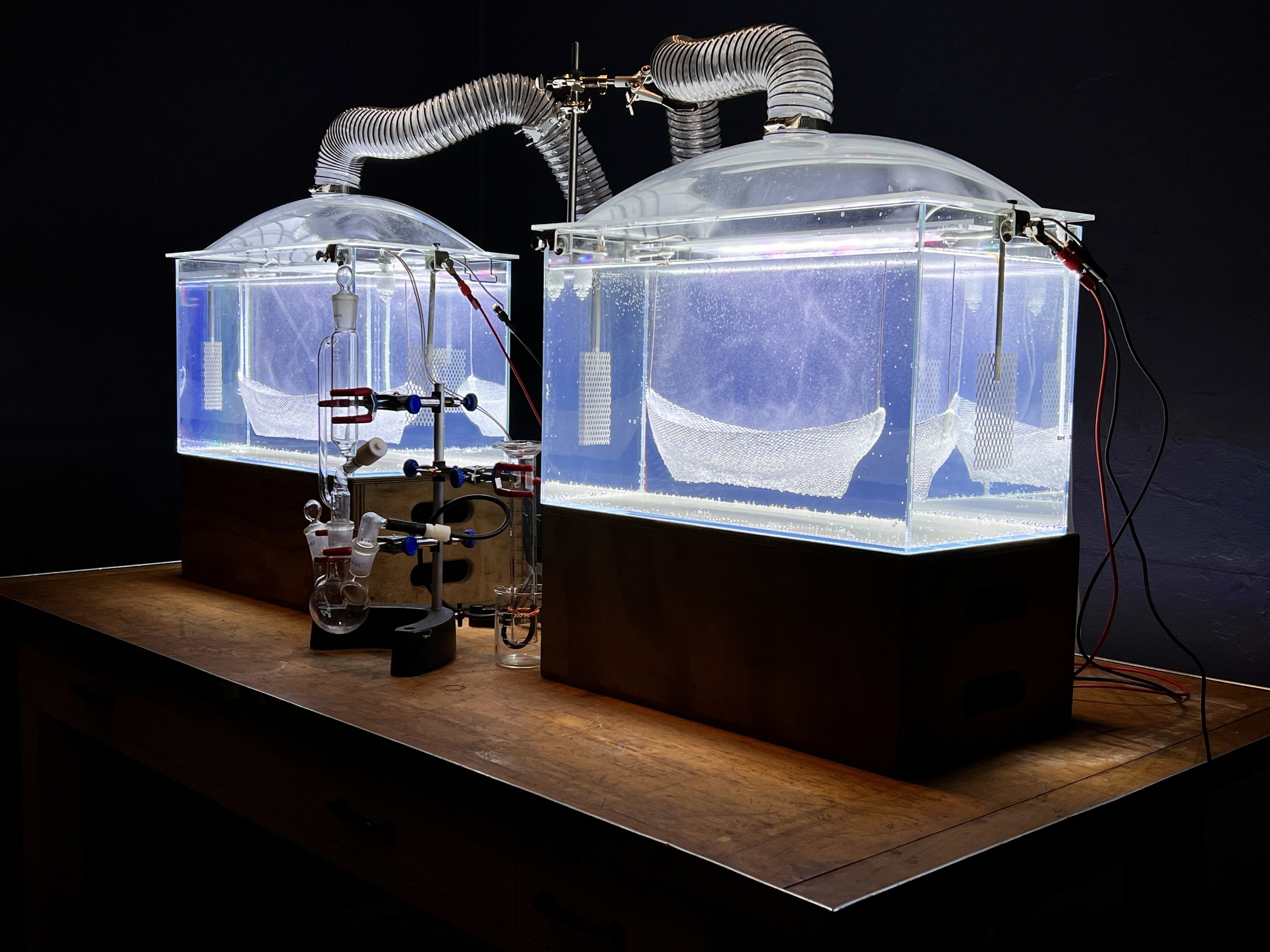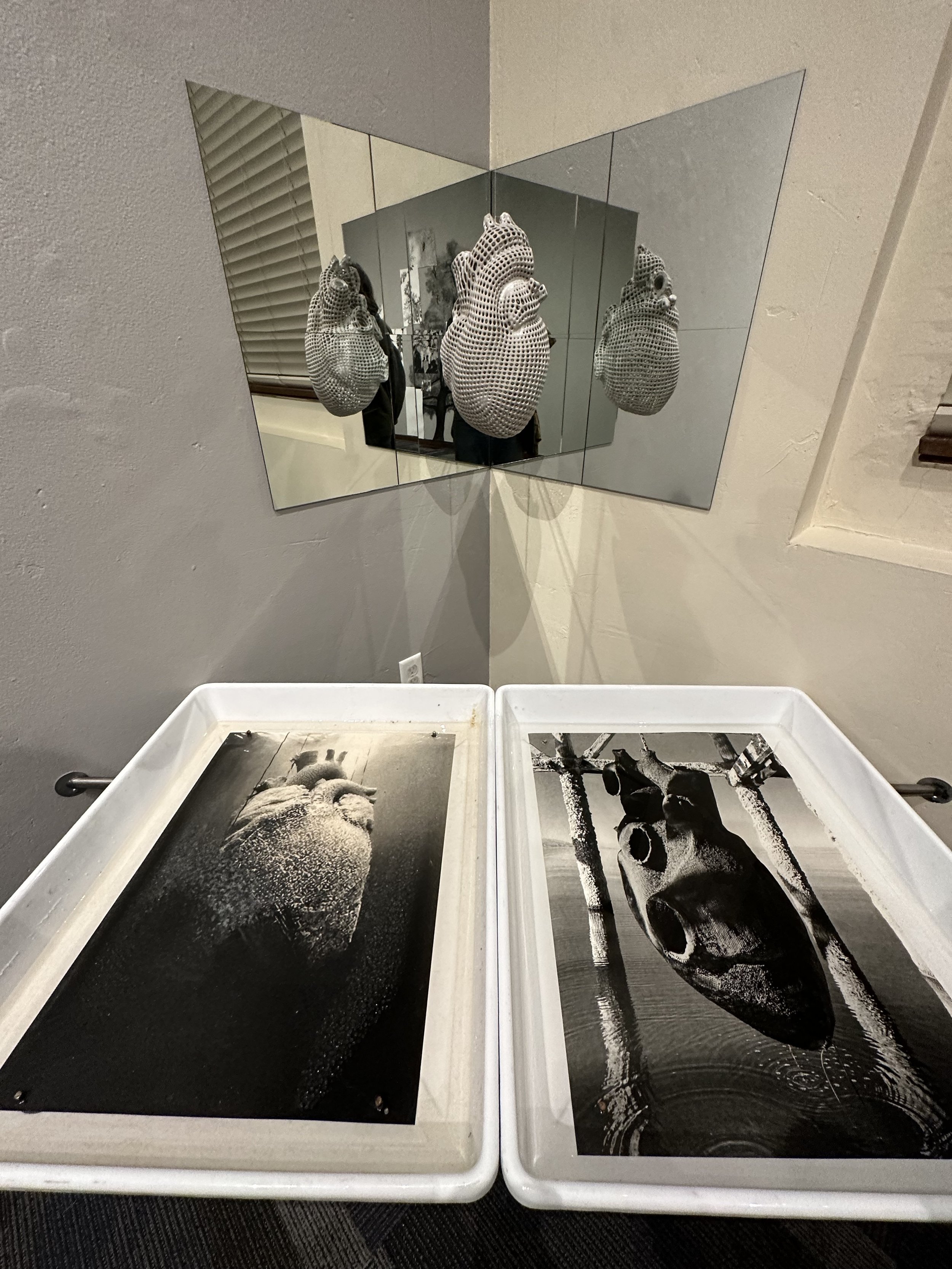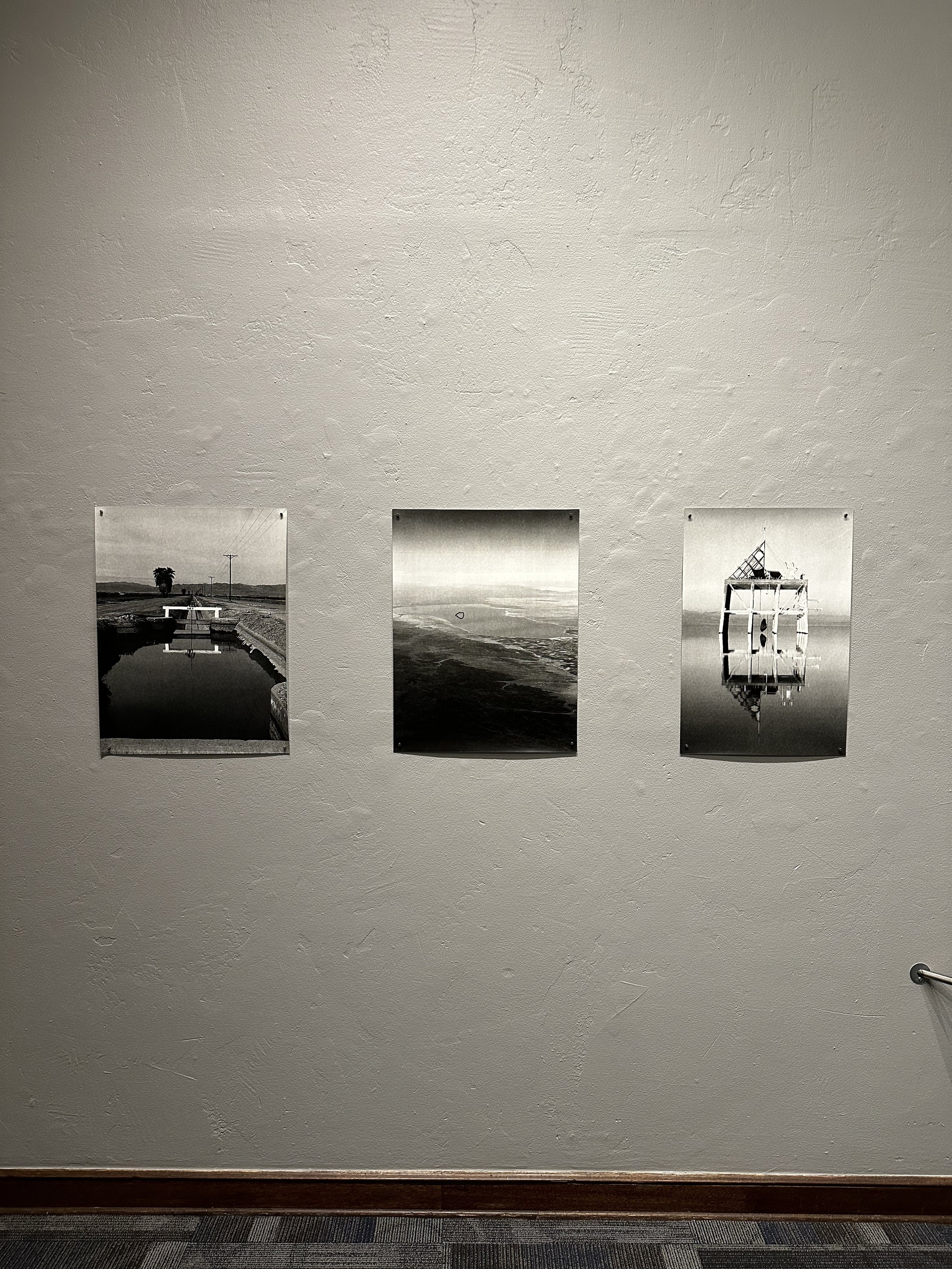LAUREN BON
Concrete is Fluid, Honor Fraser Gallery, Los Angeles, CA
Concrete is Fluid is a featured exhibition of PST ART: Art & Science Collide.
Evoking the paramount medium of industrial Los Angeles, Concrete is Fluid chronicles Bon’s creative techniques to shape, disrupt, and ultimately restore the landscape that she inhabits. Concrete serves as a conceptual anchor throughout the exhibition. While seemingly fixed and sedimentary, concrete never fully dries. Bon draws out this paradox to underscore the flexibility we must embody to meet the mounting ecological challenges at hand. Retooling the poetic utility of concrete, Bon transports us to a subterranean womb where layers of earth gestate into living metaphors of care, resilience, and mutability. In turn, visitors will find Honor Fraser transformed into an alchemical sounding board for Bon’s ecological compositions—lyrical artworks that bubble up with the sounds and aromas of life, death, and recomposition.
Central to Bon’s genre-bending art practice is her community platform, Metabolic Studio. Founded in 2005, Metabolic Studio is a nexus for artists, scientists, and activists to workshop experimental solutions to today’s most pressing environmental issues. Working with Metabolic Studio, Bon leads wide-ranging environmental projects. These interventions span from the cyborg watershed of the LA Basin to the Intermountain West, covering areas from the Sierra Nevada to the Rocky Mountains.
At the heart of Concrete is Fluid is Bon’s and Metabolic Studio’s ongoing civic enterprise “Bending the River,” an ambitious plan to redirect and reuse water flowing beneath the concrete channel known as the LA River. Now entering its tenth year of development, Metabolic Studio has acquired over one hundred federal, state, and local permits to hack the LA River’s infrastructure. Additionally, Bon has acquired the first private water right, which allows her to legally lift, clean, and transport one hundred and six acre-feet of water to the LA State Historic Park. “Bending the River” is set to conclude construction later this year. Once in operation, the intervention will form a new citizens’ utility that pioneers a broader paradigm shift toward sustainable and adaptable life-supporting systems.
Concrete is Fluid features photographic documentation and construction site ephemera from “Bending the River,” alongside performance relics and unique observational instruments made at Metabolic Studio. Bon’s exhibition, however, transcends a mere display of facts, tools, and logistics. Instead, Honor Fraser serves as a conduit between Metabolic Studio and Bon’s singular artistic vision. Bon opts for the poetics of earth, light, sound, and time. She presents artworks that reflect the spiritual and scientific rituals that she uses to evoke the planet’s sublime forces of change. Replicating these tactics at the gallery, Bon repurposes salvaged materials from construction sites and local ecological disturbances to create immersive installations. The resulting artworks form a somatic landscape that is at once playground, laboratory, and classroom.
At its core, Concrete is Fluid honors the planet’s more-than-human forces as ancient mediators of knowledge, history, and culture. Bon’s artworks accentuate the biological abundance of landslides, the maternal qualities of river wells, the photographic chemistry of watersheds, and the sonic tapestry of our industrial landscape. In the gallery’s largest exhibition space, sixty-nine “birthing figures,” made from unearthed river stones and Owens Lake crystals, pepper an undulating topography of LA Underland, pressed-earth pedestals, Salton Sea chandeliers, and cascading columns of germinating avalanche. Bon’s spiritually charged floorworks extend into the adjoining galleries, where large-scale performance artifacts echo the sacred geometry embedded throughout Bon’s photographs, collages, and site-specific rubbings.
Concrete is Fluid will also steward Metabolic Studio’s third “Un-Development” intervention, continuing a series that began in 2015. Metabolic’s “Un-Developments” reclaim urban space by peeling back layers of concrete and allowing nature to reassert itself. For “Un-Development 3,” Bon and the FarmLab team at Metabolic Studio will transform Honor Fraser’s asphalt car park into a porous floodplain for the nearby Ballona Creek. This process will involve unsealing the tarmac, dismantling the concrete, and implementing soil remediation procedures. Through a series of workshops and teach-ins, the FarmLab team will complete “Un-Development 3” in stages throughout the run of Concrete is Fluid, demonstrating how ecological reparations can be practiced on scales as small as a parking spot.
Bon’s installations, interventions, and public programming coalesce into a powerful call to action. They remind us to protect the planet’s finite resources while embracing the landscape’s generative cycles of change and restoration. Bon playfully answers her own call with a wide range of artworks that forward a tender alternative to nihilism in the face of mounting ecological precarity.
Wake Up Rainbow
Inspired by a trip to Manaus, Brazil in the Amazon rainforest, Lauren Bon began thinking about the utility of atmospheric moisture in the tropical rainforest, currently one of the most at-risk landscapes due to the logging and mineral extraction. She developed a device - contained within a single suitcase - to condense that ambient water and then, using a propulsion system, turn that water into mist and release it into the path of a bright light directed through a prism, revealing a rainbow.
A constant refrain from Brazilians living in the rainforest was that deforestation, and the loss of trees that release moisture into the air, was changing weather patterns with unexpected effects on the climate, even continents away. Wake-Up Rainbow can capture and transport a storm cloud, mimicking these weather disturbances we’re currently facing, while showing us a facet of the natural world not always visible to the naked eye.
Brackish Water, Part of The Getty's PST ART: Art + Science 2024, Cal State Dominguez Hills
Portable Wetland of Southern California
Opening August 12, 2024
Lauren Bon holds Los Angeles’ first and only private water right—Permit #21342, which allows her to annually divert 106-acre feet of water from the Los Angeles River. This river water is redirected under railway tracks to Metabolic Studio. Here the water will enter into an artificial treatment wetland comprised of native plants. The resulting regenerated water will then be redistributed to adjacent state and municipal parks on both banks of the river.
Portable Wetland for Southern California is both an experimental proposal to remediate specific ecological dysfunction and a conceptual artwork, in the form of a sculptural modular system mounted on steel supports, composed of an array of artificial wetlands tubs, water tanks, a live audio amplifier, solar energy system and other components. As a waste water river, the Los Angeles River requires treatment before it can be safely used for irrigation. In place of the energy-hungry chemical treatments typically employed by utilities to treat the river water, Portable Wetland for Southern California mimics the means by which wetland streambeds naturally cleanse water. Each tub in the array is filled with scoria, crushed volcanic rock (sourced from Payahuunadu - the Owens Valley, the source of much of Los Angeles’ water supply), which has been planted with native plants from Southern California’s rivers and streams. Additionally, the tonal frequencies continuously emitted from the installation’s audio system acts as both antibacterial agent and plant growth catalyst. Portable Wetland for Southern California is part of larger ongoing experiments being conducted at The Metabolic Studio called Undevelopment.
Conduit, Ontario Museum of History and Art
Accretion Lab
February 15 – May 19, 2024
The region east of Los Angeles in San Bernardino County, has played a pivotal role in industrial agriculture and the utilization of the Colorado River over the past century. The work that was conceived for Desert X 2023 and has been stationed in the heart of the Salton Sea since its conclusion.
Live Cam at the Salton Sea site: https://metabolicstudio.org/663
The Salton Sea, facing a dire reduction in water volume over the past 25 years, is a critical area of focus. This decline, fueled by climate change and increased water demand in Southern California, threatens local ecosystems and public health by exposing toxic agricultural runoff. Our installation at Desert X and subsequent on-site work have led to an exciting discovery: the polluted water of the Salton Sea can be regenerated. Through electrolysis, we’re sequestering carbon from the atmosphere at rates ten times higher than expected. Moreover, our process attracts metals and salts from the water, forming a protective layer around the object that includes heavy metals from industrial runoff.
This small-scale experiment called Accretion Lab, now displayed at the Ontario Museum of Art, exemplifies the potential of our work in addressing the challenges posed by desertifying lakes like the Salton Sea.
Bending The River
The concrete-lined LA River was built on top of a sprawling floodplain, which the land artist Lauren Bon seeks to reveal through a large-scale infrastructural project called “Bending the River Back to the City”. By diverting a small amount of water from the river, lifting it, cleansing it, and spreading it to a network of public parks, (its former floodplain), she renders the utilitarian water management system as an accessory of public delight and education, and begins the long process of restoring the floodplain to its natural state.
Much of Bon’s artwork is focused on closing the gap between the natural world and public life, and in this conversation she discusses the role of the artist in translating the abstraction of both natural systems and human infrastructure into experiences that are tangible and culturally meaningful. Bon also discusses her earlier work “Not a Cornfield” - in many ways a precursor to Bending the River - which aimed to transform a derelict industrial site “back into a public space — a commons — creating the possibility for a deeper public consciousness and a sense of shared ownership of LA’s historic floodplain.”
Power & Public Space is a co-production of Drawing Matter & the Architecture Foundation
Bending The River, Photo Collage 2022
Bending The River, Ceramic Pipe Photo Collage 2022
Bending The River, Site Plan 2022
This Penny Stamps Speaker Series talk is co-presented with the Community of Food, Society and Justice Conference, October 17-18. This conference will engage students, faculty, staff, farmers, and the community in rigorous dialogue around the challenges of meeting the nutritional needs of our communities, while also protecting the planet, promoting healthy lives, and ensuring food justice. The conference is free and open to the public, thanks to its co-sponsors: the U-M Residential College, East Quad Garden, Michigan Dining, U-M Sustainable Food Systems Initiative, U-M Sustainable Food Program, U-M Campus Farm, Knight Wallace House, U-M Program in the Environment, Michigan Law Environmental Law and Policy Program, U-M Museum of Anthropological Archaeology, and the Penny Stamps Distinguished Speakers Series.


























